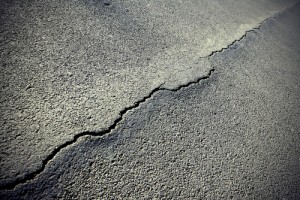Geogrid, a geosynthetic material most commonly used to reinforce soils, is often found in retaining walls and in sub-bases below structures. These materials strengthen soils and prevent cracking and breaking due to tension.
In sub-base applications for roads and sidewalks, geogrids can be added to stiffen and strengthen the soil in otherwise unfavorable conditions. This option prevents the necessity of increasing thickness with additional aggregates.
While using geogrids during initial installation of concrete, asphalt, and other materials is ideal, they can also be used to repair failures when cracking and tearing of roads begins to occur.
One example of using geogrids in repairs occurred after a 100-foot pvaement section of road exhibited signs of tearing after two days of heavy rainfall.
This failure was determined to be a lack of strength between the original road embankment and the new fill. As rainfall found its way into the soil, weight of the soil increased significantly, which began a pulling movement along this weak plane.
Upon inspection, it was found that a lack of attention had been paid to tie wedge fill to the roadway slope. That allowed for movement to begin and the resulting pavement tearing.
To fix this issue, the affected portion of pavement and soil were removed and replaced with two layers of geogrid, with limerock added to the base, and layers of asphalt.
Pavement failures like this are a perfect example of why geogrid is necessary for a variety of applications.
If your next project requires geogrids to strengthen underlying soil and base layers, contact us at Maxwell Supply in Tulsa. We carry the products you need.
